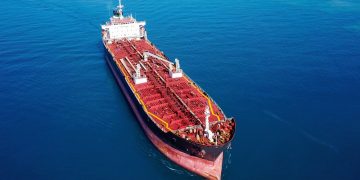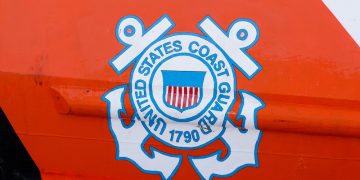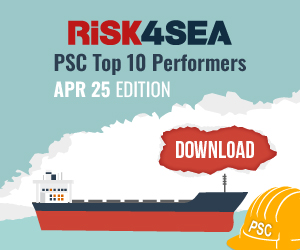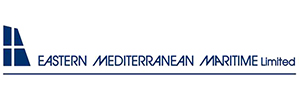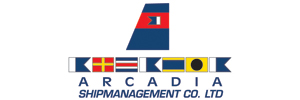The Australian Transport Safety Bureau (ATSB) has issued an investigation report into an incident where the bulk carrier Portland Bay became disabled due to engine failure in bad weather off the New South Wales coast and narrowly avoided grounding after drifting close to shore.
What happened
Portland Bay sailed from Port Kembla, New South Wales, on 3 July 2022 as bad weather was impacting its stay in port. It was expected to return when the weather improved. The ship then steamed and intermittently drifted about 12 nautical miles (miles) from the coastline. In the early hours of 4 July, the main engine developed mechanical problems, which disabled the ship 12 miles from the lee shore. A couple of hours later, after unsuccessful attempts to resolve the engine problems, the ship’s master asked Australian authorities for tug assistance.
About 2 hours later, a harbour tug from Sydney was en route but the ship had closed to one mile from the shore. The master made emergency use of both anchors to prevent stranding on the rocky shore about 12 miles south of Port Botany (Sydney) about one hour before the tug arrived to assist. In the afternoon, 2 more harbour tugs arrived on scene and later began towing the ship away from the coast. A couple of hours later in the evening, one of the tugs’ towlines parted in the rough sea conditions. The ship then drifted towards the shore and the master again anchored about one mile from the shore off Bate Bay near Sydney.
Later that night, the state’s nominated emergency towage vessel (ETV) deployed from Newcastle. The ETV arrived on scene after midday on 5 July and connected a towline in preparation to tow the ship into Sydney. On the morning on 6 July, the ETV (with harbour tugs assisting) towed the ship into Port Botany, where it was berthed in the afternoon for refuge and subsequent repairs.
What the ATSB found
Safely clearing it in accordance with its safety management system (SMS) procedures. Operating its main engine at low speed while rolling and pitching heavily resulted in engine load fluctuating with turbocharger surge and non-return flap hammering and distortion. Performance was further degraded by a leaky fuel injector, poor combustion and excessive cylinder lubrication resulting in sludge and deposits. When one of the 2 auxiliary blowers failed in the early hours of 4 July, air for fuel combustion significantly reduced and engine speed was limited to the minimum, effectively disabling the ship in bad weather.
 The investigation also identified that when the master reported the situation to the ship’s managers, Pacific Basin Shipping, it provided advice on engineering matters but not about notifying authorities as per the SMS procedures. This probably led the master to delay reporting to Port Kembla vessel traffic service (VTS) operated by the Port Authority of New South Wales (Port Authority). This delay was compounded when VTS did not promptly forward the master’s report to the Australian Maritime Safety Authority (AMSA).
The investigation also identified that when the master reported the situation to the ship’s managers, Pacific Basin Shipping, it provided advice on engineering matters but not about notifying authorities as per the SMS procedures. This probably led the master to delay reporting to Port Kembla vessel traffic service (VTS) operated by the Port Authority of New South Wales (Port Authority). This delay was compounded when VTS did not promptly forward the master’s report to the Australian Maritime Safety Authority (AMSA).
The various delays resulted in delaying the tug assistance requested and the master had to deploy both anchors to prevent stranding. In addition, the investigation identified several safety issues associated with the emergency response. Specifically, AMSA procedures to comply with the National Plan for Maritime Environmental Emergencies (National Plan) were not effectively implemented. Similarly, the Port Authority’s procedures to comply with the NSW Coastal Waters Marine Pollution Plan (NSW Plan) and its Port Safety Operating License (PSOL) were not effectively implemented.
Further, the coordination of critical elements of the emergency response, including emergency towage, salvage and refuge, between the Port Authority, Transport for NSW (NSW Maritime) and AMSA with their respective roles and responsibilities was inadequate and inconsistent with National Plan principles. These safety issues prolonged the emergency and the exposure to stranding, with potentially severe consequences.
The ATSB also found that the AMSA process to issue directions was inefficient and resulted in excessive time to issue directions to enable Portland Bay to enter Port Botany for shelter. While this delay did not further prolong the emergency, such delays increase risk in time-critical situations. The investigation also found that United Salvage, the salvor, was severely limited in its ability to provide the salvage services required as it did not own or operate any towage vessels so was reliant on towage providers.
This limitation was not made clearly known to the ship’s master, owners or managers or the involved agencies to allow them to properly assess whether the most suitable towage vessels, including the ETV, had also been promptly deployed.
A key finding was that the ship’s anchors prevented a catastrophic stranding on the rocky shore in heavy weather, noting that they were not designed for such use but can be used as a last resort in emergencies.
Contributing factors
- After departing Port Kembla in adverse weather on 3 July 2022, Portland Bay’s master steamed slowly or drifted about 12 miles off the coast instead of safely clearing it in accordance with the ship’s safety management system procedures.
- Operating the main engine at low speed while the ship was rolling and pitching heavily exacerbated engine load fluctuations due to turbocharger surge and non-return flap hammering. Engine performance was further degraded by a leaky fuel injector, poor combustion and excessive cylinder lubrication, which resulted in sludge and deposits accumulating in the engine scavenge spaces, blow by and sticky piston rings.
- The main engine auxiliary blower number 2 impeller bearings failed in the early hours of 4 July. This was most probably due to prolonged operation with an unbalanced impeller and oversized bearing housing, aggravated by varying engine load due to the ship’s rolling and pitching.
- The failure of auxiliary blower number 2 substantially reduced the normal airflow to the engine. In addition, some air was recirculating to the blower inlet through a distorted turbocharger delivery non-return flap. The resulting low airflow limited the engine speed to 42 rpm (dead slow ahead setting) and significantly reduced the propulsive power available.
- The significant loss of Portland Bay’s propulsive power in the prevailing gale force winds, very rough seas and heavy swell effectively disabled the ship and resulted in it drifting towards the lee shore.
- Portland Bay’s manager, Pacific Basin Shipping, did not provide the master advice about notifying authorities as per the ship’s safety management system emergency procedures, instead focusing on the engineering matters. This probably led to the master delaying the notification and the request for tug assistance. (Safety issue)
- Portland Bay’s master notified Port Kembla vessel traffic service that the main engine had failed and requested tug assistance about 2 hours after the ship was disabled. This delay significantly reduced the time available to Australian authorities to respond and for tugs to assist the ship in time to avoid a stranding.
- Port Kembla vessel traffic service delayed notifying the Australian Maritime Safety Authority (AMSA) about the incident for 45 minutes. This delay reduced the time available to AMSA to initiate and coordinate an emergency response.
- SL Diamantina, the harbour tug that arrived about one hour after the ship anchored, was not capable of providing any useful assistance in the rough weather. About 6 hours later, SL Martinique and Bullara, harbour tugs temporarily equipped with additional towing equipment, began an attempt to tow the ship clear of the coast, but this was beyond their combined capabilities in the weather conditions with the towing lines deployed.
- The Australian Maritime Safety Authority’s Maritime Assistance Services procedures to support the National Plan for Maritime Environmental Emergencies (National Plan) were not effectively implemented. Consequently, there was a 12-hour delay in tasking the state’s nominated emergency towage vessel, Svitzer Glenrock, which significantly prolonged the emergency. (Safety issue)
- Portland Bay was exposed to a high risk of stranding, with its anchors deployed for prolonged periods about one mile from a dangerous lee shore in 2 separate locations.
- Having assessed that the failed blower’s electric motor was also unserviceable, the ship’s engineers were unable to remove it and abandoned the repairs without testing it. Had the motor been tested, it would have been found operational and the blower returned to service to improve engine performance and reduce the seriousness and duration of the emergency.
- Port Authority of New South Wales procedures to comply with its Port Safety Operating Licence and the NSW Coastal Waters Marine Pollution Plan were not effectively implemented. This resulted in delays to the required notifications and incident response, which contributed to prolonging the emergency. (Safety issue)
- The Port Authority of New South Wales did not have a proper and correct understanding of its responsibilities for emergency response under its operating licence and relevant state plans. This contributed to the inadequate coordination of emergency towage, salvage and refuge, which were critical for the single, integrated and comprehensive response required and significantly prolonged the emergency. (Safety issue)
- Transport for NSW (NSW Maritime), as the statutory agency responsible for ensuring that New South Wales was prepared to respond to an incident in accordance with the state’s plan that it maintained, had not effectively met this obligation. This resulted in the long delay in New South Wales assuming control of the incident and contributed to the inadequate coordination of the emergency response required for a single, integrated and comprehensive response and significantly prolonged the emergency. (Safety issue)
- The Australian Maritime Safety Authority, with direct control of key national emergency response arrangements, did not have the required understanding of its central role in any response, regardless of location. Consequently, its support to, and coordination with, the control agency in relation to emergency towage, salvage and refuge was inadequate, inconsistent with National Plan principles of a single, integrated and comprehensive response and significantly prolonged the emergency. (Safety issue)
- The Australian Maritime Safety Authority had not adequately managed the National Plan and annual exercises required to prepare for such incidents had not been conducted for 4 years before the incident. This probably resulted in the ineffective implementation of its Maritime Assistance Services procedures, the inefficient process for issuing directions and inadequate coordination of the incident with state authorities. (Safety issue)
Other factors that increased risk
- United Salvage was severely limited in its ability to provide the required salvage services as it did not own, operate or directly control any towage vessels for which it relied on towage providers. This limitation was not made clearly known to Portland Bay’s master, owners or managers or involved authorities to allow them to properly assess whether the most suitable towage vessels, including the emergency towage vessel, had also been promptly deployed for salvage and emergency response. (Safety issue)
- The Australian Maritime Safety Authority’s process to issue directions was inefficient and resulted in excessive time to issue directions allowing Portland Bay to enter Port Botany as a place of refuge. While this delay did not further prolong the emergency, such delays increase risk in time-critical situations. (Safety issue)
Other findings
- Portland Bay’s emergency anchoring prevented a catastrophic stranding on the rocky shore in heavy weather (anchoring equipment is not designed to hold a ship in rough weather).
- The attempt to rescue Portland Bay’s crew by helicopter in case it stranded was appropriate, as was its risk-assessed suspension after the ship’s anchors reduced the risk of stranding.










